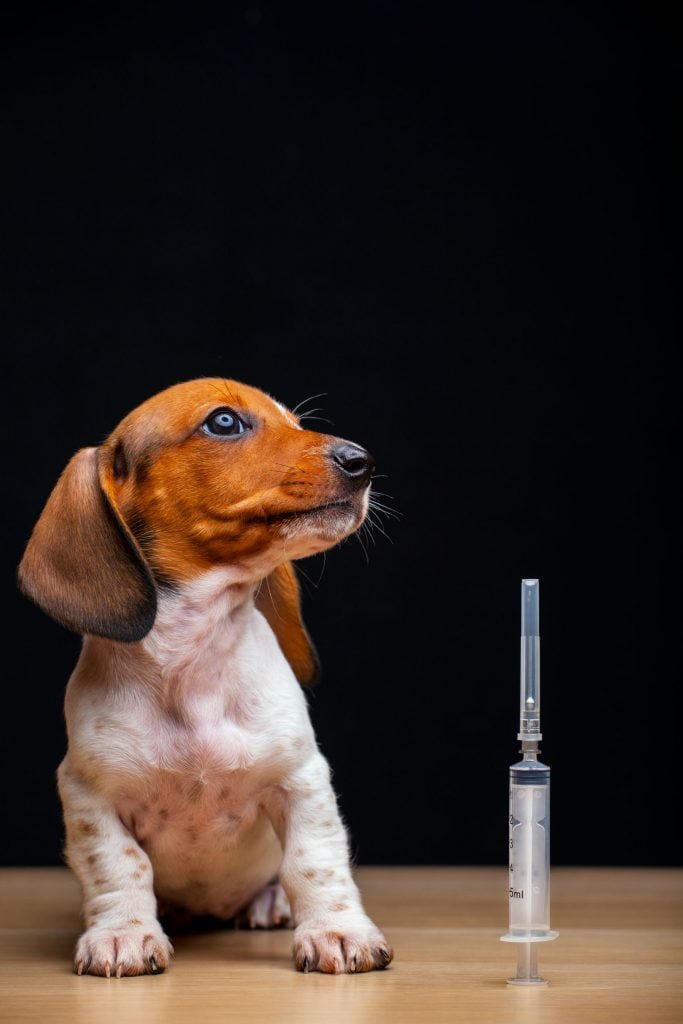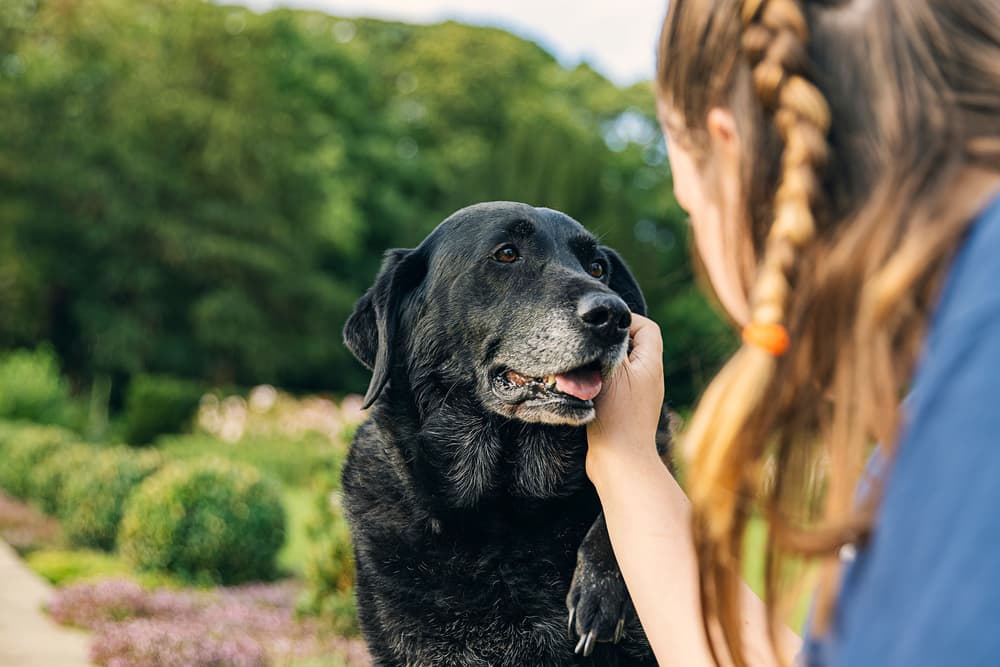
Unfortunately, insulin-dependent diabetes in dogs is relatively common. This type of diabetes occurs when the pancreas stops producing enough insulin.
Diabetes may be found on routine diagnostics. It can also be found when your dog is showing signs of diabetes and needs to go to the veterinarian.
If a non-routine appointment is scheduled, the cost to diagnose diabetes is usually $225 to $350. This includes the full bloodwork required to begin a treatment plan.
To simply say “yes” or “no” to a diabetes diagnosis, the cost would only be $50 to $100.
A year of diabetes treatment for a dog costs roughly $700 to $2,800.
A typical annual cost for a small dog would be $1,000. The typical annual cost for a large dog would be around $1,500. The majority of this cost is insulin.
Costs in the $2,000 range would be due to severe diabetes or diabetes that is difficult to manage. Severe diabetes increases insulin cost. Difficult to manage diabetes increases the glucose testing cost.
There are places to save when treating a diabetic dog. These include choosing a cost-effective insulin brand, shopping for insulin prices, and performing glucose testing at home.
Keeping a healthy weight and feeding a high fiber diet can reduce the need for insulin over time. This can save significant money in the long-run.
Breaking Down the Cost of Canine Diabetes Treatment
- Diagnosis
There are various signs that would make a veterinarian suspect diabetes. These include increased thirst and urination, appetite changes, muscle wasting, and cataracts.
First, the veterinarian will do a full physical exam which costs $50 to $80. The vet will look at the eyes to check for any damage from diabetes.
The most cost-effective way to confirm diabetes is a urine glucose test. This costs $5 to $20 but will give you little information about your dog’s health beyond a diabetes diagnosis.
A urine test can only find more severe diabetes. Blood chemistry, CBC, and urinalysis are the recommended tests for a diagnosis.
These tests will reveal how diabetes has affected your dog and if there are any other issues occurring. The cost is roughly $175 to $250.
- Insulin
In dogs, diabetes is always a deficiency of insulin production in the pancreas. This insulin will need to be replaced with injections every 12 hours.
The amount of insulin required is different for every dog. Even the same dog can require different amounts of insulin over time.
For a 10-pound dog, a 10 ml vial of Vetsulin will last 20-40 days. For an 80-pound, a 10 ml vial will last 5-20 days.
Brands of insulin sold for humans are 2.5 times more concentrated. This means that a 10 ml vial will last 2.5 times as long.
However, insulin expires 30-40 days after it is opened. Generally, the cost of insulin for dogs will range from $40 to $80 per month for small dogs and $80 to $150 per month for large ones.
- Glucose Curve Test

To determine your dog’s dosage, a glucose curve test will be done. Your dog will spend a day at the animal hospital.
He will eat its regular meal at its regular schedule and will receive his insulin injection. Every two hours, blood glucose will be measured.
Based on these results, the veterinarian will determine if the insulin dose needs to be increased, decreased or remain the same. This test costs roughly $60 to $150.
The test will need to be repeated every 7-14 days until the correct insulin dose is determined. Usually, about 2 tests are required.
If preferred, a glucose curve can also be done at home. A dog glucose meter costs roughly $60, which includes 25 test strips.
A veterinary technician can show you how to prick the ear to obtain blood for this test. An at-home test is usually more accurate because your dog is more comfortable and can do their daily activities.
- Ongoing monitoring
Every 3 to 12 months, your dog will need to have his insulin dose checked. This can be done with another glucose curve or a fructosamine blood test.
A fructosamine test costs $60 to $100 and requires only one blood draw. It will reveal your dog’s average blood glucose over the past ten days or so.
Urine glucose test strips can also be purchased for regular at-home monitoring. This can be a very cost-effective way to keep an eye on your dog’s glucose levels.
A package of 100 test strips costs roughly $15. Blood glucose over 150 mg/dL is considered too high for diabetic dogs. Urine will contain glucose ONLY when your dog’s blood glucose is over 200 mg/dL.
Every 6-12 months your dog should get a physical exam, a blood chemistry panel, CBC, and urinalysis. This is to ensure there are no other medical issues occurring.
Catching medical issues early is critical in a diabetic dog. The exam will cost $50 to $80 and the bloodwork and urinalysis will cost $175 to $250.
- Additional Treatments
Female dogs with diabetes should be spayed. The reproductive cycle of female dogs makes it extremely difficult to regulate blood glucose. The cost of dog spaying is around $30 to $300 depending on the facility and location.
Diet and weight loss are also critical in helping diabetic dogs. Overweight dogs need their food cut back until they return to their ideal weight. Your veterinarian will advise you on how to best approach weight loss.
Prescription dog food can help with maintaining glucose levels and a healthy weight. This kind of diet is roughly $30 for an 8.5-pound bag of commercial dog food and $80 for a 27.5-pound bag.
If cost is a concern, it is advised to find a quality dog food that is high in fiber and low in fat.
Types of Diabetes
There are two kinds of diabetes: Type I and Type II. Type I or insulin-deficiency diabetes happens when the endocrine pancreas is too damaged to produce enough insulin in the body.
Type II or insulin-resistance diabetes, on the other hand, happens when the body, while able to produce insulin, doesn’t have the capacity to properly make use of it. Type II hasn’t yet been noticed in dogs, according to studies conducted.
A quick blood and urine test will identify whether your dog has diabetes or not.
Your dog could potentially develop cataracts which could lead to blindness if the diabetes goes untreated or poorly managed. The treatment cost for cataract has a price range of $3,500 to $4,500. Pancreatitis is also a common occurrence in diabetic dogs, which would cost around $100-200 to treat on average without hospitalisation. Closely monitor diet to help prevent pancreatitis.
With proper guidance, you would be able to find the best medical treatment for your beloved pet.

Thank you for all of this information!
What dog food do you recommend to help fight the diabetes?
Do you know of any organization that can help us afford the medical care for our lab?
Thank you your information has been very helpful.